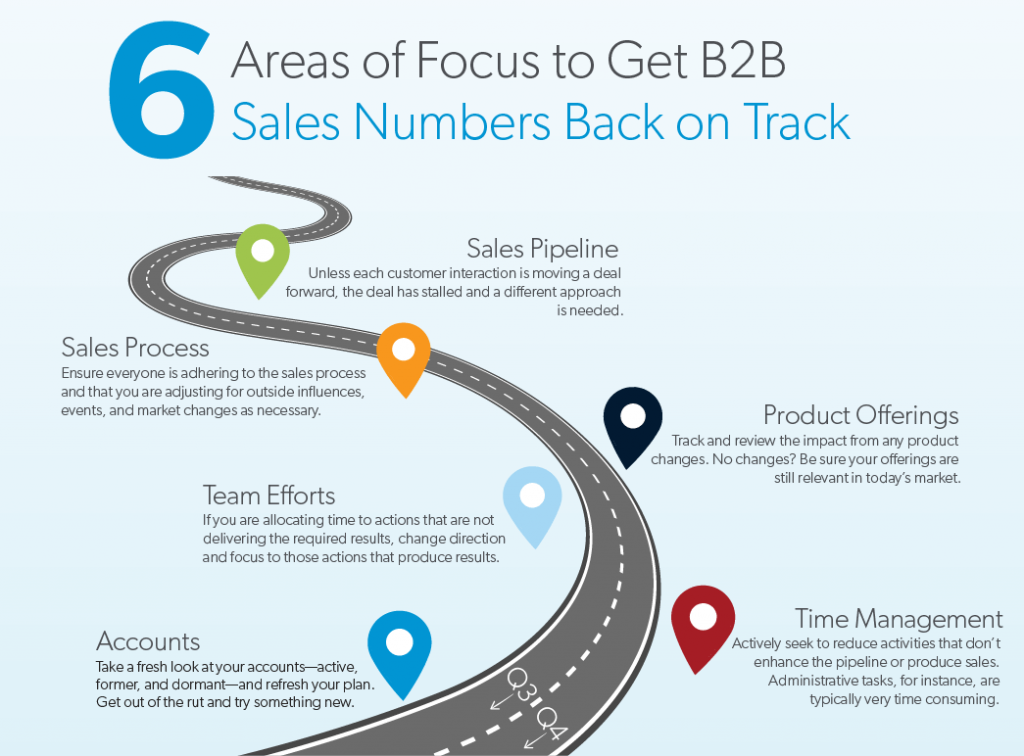You’re not alone. This can happen to the best sales folks, and there’s no need to panic. You can still turn things around, meet your goals, and experience a successful second half of the year. Now is the time for you and your team to take an honest look at what’s going on and where you need to change or shift focus. Consider the following areas.

Sales Pipeline
You need to understand your gaps by answering some questions. Are the stages in your B2B sales pipeline accurate? Do you have the right volume in each stage to achieve your numbers based on your sales cycle?
How many stalled deals are there? How much time are you spending on the deals that are not advancing through the sales cycle or pipeline? A best practice is to complete a formal assessment for each opportunity, which should contain a detailed analysis for identifying potential shortcomings and areas for improvement.
It is important to understand that unless each interaction with a customer is moving a deal forward, the deal has stalled and a different approach is needed. Doing what has been successful in the past may not work with every new deal. Think of creative ways or different approaches that may produce the desired results. Actively seek the advice of coworkers to benefit from what has worked for them.
Unfortunately, even if you have done everything correctly in the sales process, it can still stall. For projects that appear to be stalled, sales guru Leigh Ashton recommends that you question those customers (assuming you have good rapport). She says you should ask them to rate the chances of closing the deal within a time frame on a scale of 1-10. While your customer may go silent for a bit, she says, “What you are asking them to do is equate everything that’s going on in their head to a number. If they give you a high number, you can ask the question that identifies the gap—What needs to happen to get us to a 10?”
Ashton says that, in most cases, what you actually get is a whole load of information about why they are not saying yes right now. Of course, some things you can’t control, but once you are armed with the information, you can begin to see what needs to be done to move in the right direction. This information also helps you access how best to spend your time, in order to hit your Q3 and Q4 B2B sales goals. If a customer expresses issues you believe may preclude them from signing a deal in the next six months, you can more accurately assess your pipeline and begin to adjust for the gap.
Sales Process
- Is everyone adhering to the sales process? Are potential outside influences, events, or market changes making it necessary to make some adjustments?
- Are you panicking or getting down on yourself? Confidence, enthusiasm, and attitude are all necessary when selling.
- From an individual salesperson’s perspective, examine what you have done previously to be successful.
- Are you keeping the same routine and rhythm?
- Are you finding yourself slacking a bit in areas of the sales process where you are uncomfortable?
- Have you stopped focusing on certain aspects of the sales process due to lack of short-term success?
- Refocus yourself on your sales process and doing the right thing every time.
- Take a deep dive into your competition to make sure that there have not been dramatic changes in products offered, pricing, or go-to-market strategy, which might be impacting your ability to compete.
Team Efforts
According to the American Psychological Association’s Review of General Psychology, 92% of football coaches believe their performance is “crucially determined by momentum.” Simply put, regardless of whether or not it’s true, initial success frequently leads to more success. Perceived momentum leads to increased confidence, which in turn leads to more activity and better performance.
- Who are achieving their numbers? Who are not? Why? What can you learn from the top performers that can help the underperforming ones?
- Often teams in this situation focus on the actions they are taking rather than what the actions are accomplishing. If you are allocating valuable time to actions that are not delivering the required results, change direction and focus to those actions that produce results.
- Take a cue from football coaches and consider “restabilizing” the psychological momentum of your team. When individuals have psychological momentum, they are in a constant state of believing everything will go their way. Couple that with hard work and execution, and success can be regained.
Product Offerings
Have you had any changes to your product offerings? If so, can you see any negative impact as a result? Review the changes. Is the problem you or your team? Were you more comfortable selling the previous products? Are you fully versed on the benefits your new products offer? If not, work diligently to increase your acumen, comfort level, and knowledge to create more impactful interactions with your customers.
If customer feedback for your new offerings has been negative or lukewarm, then research and investigate the reasons, review with the team, and consider delivering a fact-based report to management outlining your concerns. Remember to always look at yourself first to make sure you are doing everything in your control to move the needle.
Are all your product or service offerings relevant in today’s market? Large changes might not be possible, but sometimes revisiting your solution and making small changes can have a huge impact. If you do make changes, remember it’s necessary to measure the impact. It is very important to understand what changes have and have not been successful.
Accounts
Review all your accounts.
- Are there accounts that, even though they are not producing sales, you consistently call upon, because you are comfortable with them?
- Are there dormant accounts you have stopped calling because of the assumption that they have no needs?
- Are there former accounts you are overlooking?
Take a fresh look and revise your plan. Get out of the rut of calling the same old accounts, and get excited about trying something new.
Time Management
Assess how your (as well as the team’s) time is being spent. While we all know that selling, prospecting, and problem solving are the most important activities for salespeople, the reality often looks similar to this:
- Administrative tasks = 31%
- Travel time = 18%
- Personal phone calls and emails = 17%
- Problem solving = 14%
- Prospecting = 10%
- Active selling = 10%
OUCH! On average, less than 35% of a salesperson’s time is spent on activities directly resulting in sales and a more robust pipeline. Take an immediate assessment, and actively seek to reduce activities that won’t enhance your pipeline or produce sales. Keep the main thing the main thing!
It’s Not Over
The point is, regardless of your current state, it is possible to get your B2B sales numbers back on track. Get back to the basics, focus on the fundamentals, and treat each customer interaction with renewed energy and excitement.
MarketSource would love to help. Better sales begin with a MarketSource assessment. Contact us now, and let’s get started!

